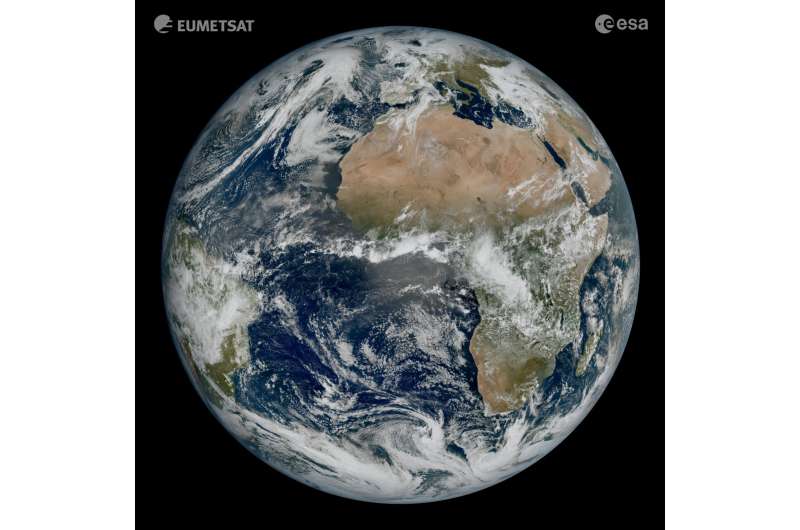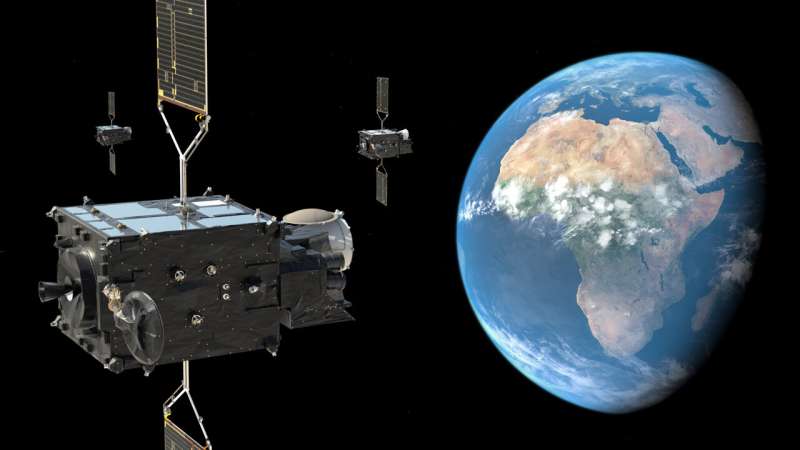This article has been reviewed according to Science X's editorial process and policies. Editors have highlighted the following attributes while ensuring the content's credibility:
fact-checked
trusted source
proofread
New weather satellite reveals spectacular images of Earth

Europe's latest weather satellite, the Meteosat Third Generation Imager, has just delivered its first view of Earth—revealing conditions over Europe, Africa and the Atlantic in remarkable detail.
Launched on an Ariane 5 rocket on 13 December 2022, the Meteosat Third Generation Imager-1 (MTG-I1) is the first of a new generation of satellites set to revolutionize weather forecasting in Europe. ESA and Eumetsat are proud to jointly release the new image from the next generation.
The image, which was captured by the satellite's Flexible Combined Imager on 18 March 2023, shows much of Northern and Western Europe and Scandinavia blanketed in clouds, with relatively clear skies over Italy and the Western Balkans.
ESA's Director of Earth Observation Programs, Simonetta Cheli, said, "This image is a great example of what European cooperation in space can achieve. The level of detail MTG-I1's image reveals, unachievable over Europe and Africa from a geostationary orbit until now, will give us a greater understanding of our planet and the weather systems that shape it.
"This image represents not just what can be achieved through European expertise but our determination to ensure the benefits of new technology are felt by communities in Europe and beyond."
Instruments onboard the third generation of Meteosat meteorological satellites produce imagery with a much higher resolution, and more frequently, than those on the Meteosat Second Generation satellites.
Details such as cloud vortices over the Canary Islands, snow cover on the Alps and sediment in the water along the coast of Italy are visible in the image. These details are not as clearly visible, or not visible at all, in images from the instruments on the current second-generation spacecraft.
The new image also reveals a greater level of detail of cloud structures at high latitudes. This will enable weather forecasts to monitor the evolution of rapidly developing severe weather more accurately in that region.
Phil Evans, Director General at Eumetsat, added, "This remarkable image gives us great confidence in our expectation that the MTG system will herald a new era in the forecasting of severe weather events.
"It might sound odd to be so excited about a cloudy day in most of Europe. But the level of detail seen for the clouds in this image is extraordinarily important to weather forecasters. That additional detail from the higher resolution imagery, coupled with the fact that images will be produced more frequently, means forecasters will be able to more accurately and rapidly detect and predict severe weather events."
"The high-resolution and frequent repeat cycle of the Flexible Combined Imager will greatly help the World Meteorological Organization community to improve forecasts of severe weather, long-term climate monitoring, marine applications, agricultural meteorology, and will make an important contribution to the Early Warnings For All Initiative, in particular on the African continent," added Natalia Donoho, Head of the World Meteorological Organization Space Systems and Utilization Division, WMO.
MTG-I1 is currently undergoing a 12-month commissioning phase, in which its instruments, the Flexible Combined Imager and the Lightning Imager, are switched on and the data they produce are calibrated. Data from the satellite will then be disseminated to meteorological services in Europe and beyond at the end of 2023, for operational use in weather forecasts.
The ground segment infrastructure required to routinely process images was used to produce this first image, as a preview of things to come this year. Images of the full Earth disk will be produced every 10 minutes when the system is fully operational.
The MTG satellites are built by a large consortium of European industries, led by Thales Alenia Space in cooperation with OHB. The innovative Lightning Imager was developed by Leonardo in Italy, while Telespazio provides Eumetsat with launch and in-orbit services.

A new era of satellite meteorology
MTG-I1 is the first of six satellites that form the full MTG system, which will provide critical data for short-term and early detection of potential extreme weather events over the next 20 years. In full operations, the mission will comprise two MTG-I satellites and one MTG Sounding (MTG-S) satellite working in tandem.
The MTG-S sounding satellites—a first for Meteosat—will carry an Infrared Sounder and an Ultraviolet Visible Near-Infrared spectrometer. By monitoring atmospheric instability in three dimensions throughout the clouds, the sounder will offer a major step forward for early warnings of severe thunderstorms and is expected to provide unique information from geostationary orbit on ozone, carbon monoxide and volcanic ash composition within the atmosphere.
Currently the revolutionary Infrared Sounding instrument is in its final performance characterization before being delivered to Bremen, Germany, for MTG-S satellite integration. It is expected that the satellite will be completed by mid-2024, with a target launch before the end of the year.
Paul Blythe, ESA's Meteosat Program Manager, commented, "Following the launch of the MTG-I1 satellite, the momentum in the MTG program is relentless. On the one side we are supporting the operations and data analysis of the first satellite in orbit, whilst on the other, we push forward to ensure the availability and performance of the all-new MTG Sounding satellite.
"The initial results from MTG-I1 are hugely motivating for those who have worked on the program and creates a major impetus to complete the full MTG constellation by 2026."
Provided by European Space Agency





















